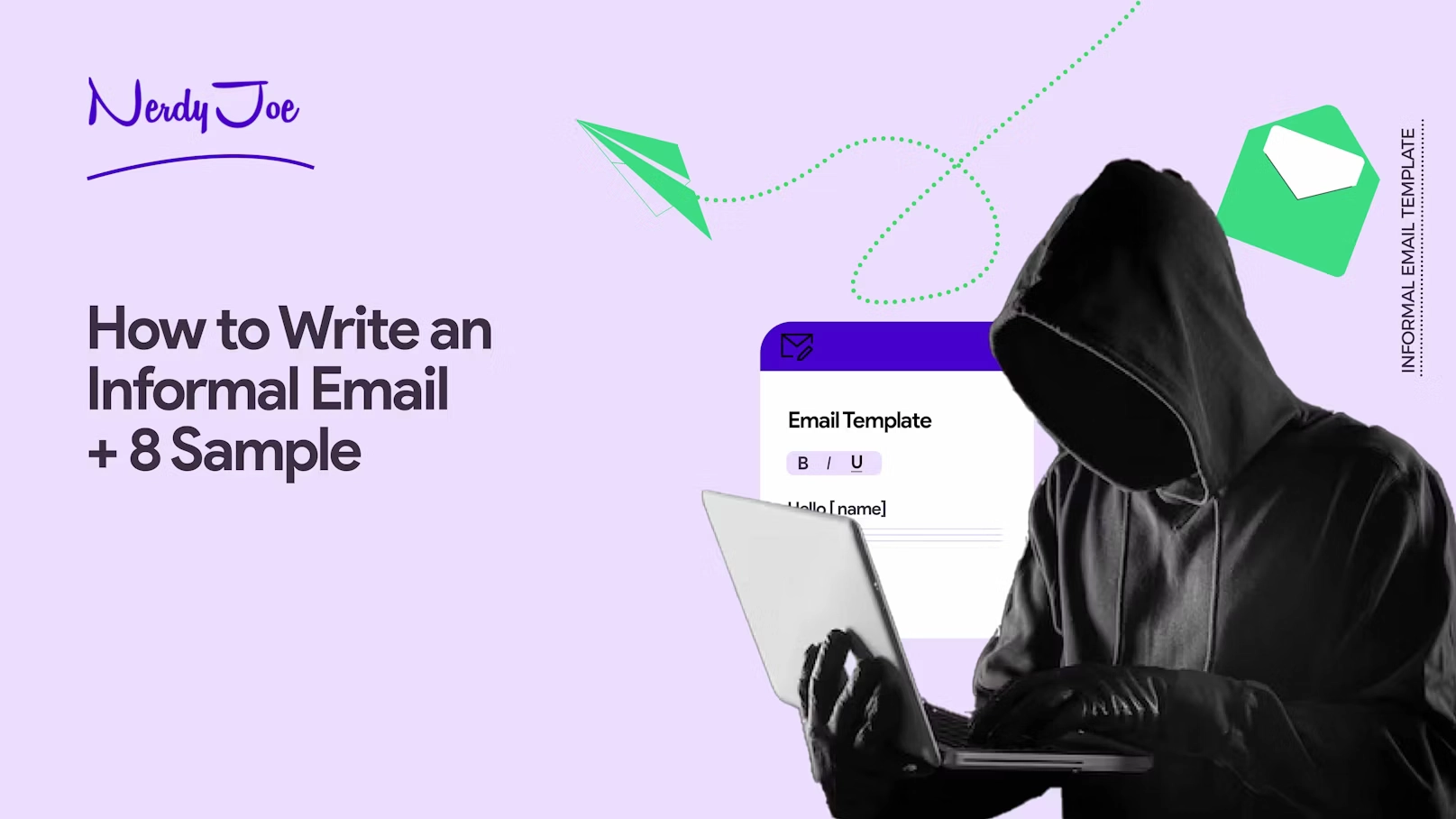LinkedIn InMail and email are the two most discussed prospecting and outbound lead generation strategies. There are many differences in the benefits each strategy offers.
The basic differentiator is the price. LinkedIn InMail requires a premium monthly or annual subscription. Email, on the other hand, costs absolutely nothing.
But as a marketer or SDR looking to discover the best strategy to approach, engage, educate, and convert your prospects, you need to further compare the two tools. We’ve got you covered.
In this article, we will compare LinkedIn InMail and email based on the advantages and limitations each strategy has, taking into account your needs and objectives as a marketer or SDR.
Note: Struggling to fill your calendar with sales-qualified meetings? For $799/month, we’ll book 5 meetings with sales-ready prospects for you every moTL;DR
| Comparison Values | InMail | |
|---|---|---|
| Shorter processes | Yes ✅ | No 🚫 |
| Limited messages | Yes 🚫 | No ✅ |
| Limited sendings | Yes 🚫 | No ✅ |
| Extra pay for more features | Yes 🚫 | No ✅ |
| Higher and faster engagement | Yes ✅ | No 🚫 |
| Analytics | No 🚫 | Yes ✅ |
| Segmentation features | No 🚫 | Yes ✅ |
| Automation features | No 🚫 | Yes ✅ |
| Follow up flexibility | No 🚫 | Yes ✅ |
| High-value prospects | Yes ✅ | Yes ✅ |
| Restrictions and ban risk | Yes 🚫 | No ✅ |
| Professional | No 🚫 | Yes ✅ |
| Potential deliverability issues | No ✅ | Yes 🚫 |
| Bulk messages | No 🚫 | Yes ✅ |
| Best timing for sending | Yes ✅ | No 🚫 |
| Personalization features | No 🚫 | Yes ✅ |
| Flexibility and scalability | No 🚫 | Yes ✅ |
| Gives more work | No ✅ | Yes 🚫 |
| Best bang for your buck | No 🚫 | Yes ✅ |
What is LinkedIn InMail?
InMail is a premium LinkedIn outreach service that allows you to send promotional messages to your target LinkedIn users on the platform. It is also known as sponsored InMail.
Think of it as an emailing tool integrated into LinkedIn that lets you reach any LinkedIn member you want, without having to search for their email addresses or sending them a connection request.
How does inMail work?
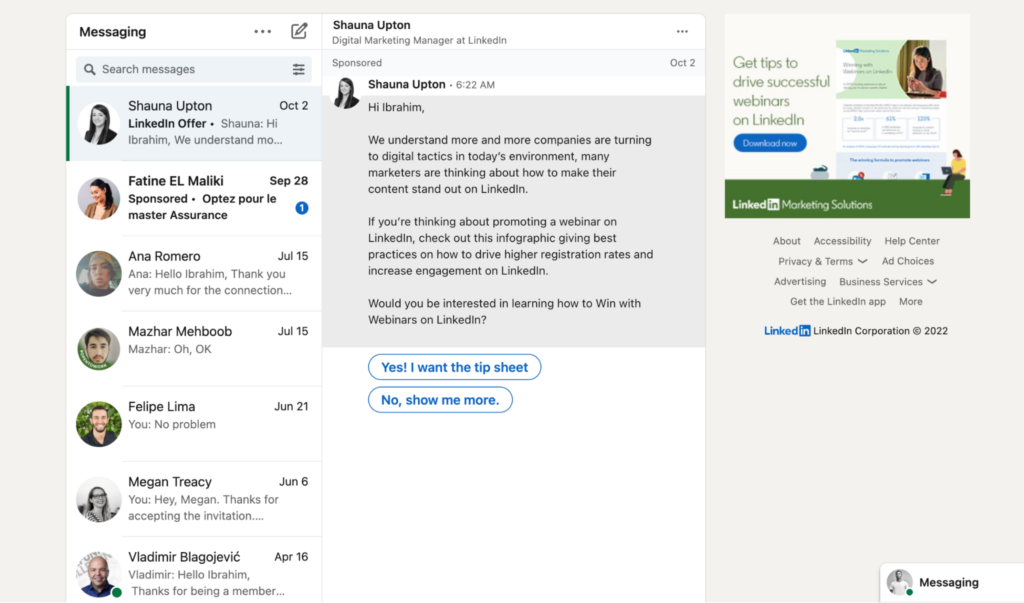
LinkedIn has a native messaging system that all (free and premium) LinkedIn members can use to send messages to one another between connections.
The problem is that in order to do lead generation, you have to send messages to people you don’t necessarily have a relationship with.
In the context of LinkedIn, that comes down to people outside of your connection. This is where InMail comes in handy.
Normally, you can only send a LinkedIn message to someone if you are connected to each other.
InMail is a premium feature designed to allow you to send LinkedIn messages to people outside your network, usually 2nd or 3rd connections.
Always keep in mind that you’ll have to first pay for LinkedIn Sales Navigator or upgrade to a LinkedIn premium account to get InMail credits (the number of people you can target as per your plan).
The main advantage of using InMail messages is that it allows you to target the prospects you find on the platform—right on the platform.
This saves you time, and your prospects can easily check your LinkedIn profile to see who is targeting them.
You won’t have to worry about your message being rejected or reported as spam. You can also use users’ data on the platform (i.e., their latest activities) to create personalized messages to send them.
On top of that, you can use LinkedIn message subject lines to boost your success rate.
In a nutshell, there is a much higher chance that your recipient will trust your message and eventually read it.
It’s fast, and you won’t have to worry about performing too much research as you would with email.
Read more: How to Write Cold Email Opening Lines That Get Replies
What is email?
(Cold) Email is one of the oldest outbound lead generation channels, and multiple companies have grown on the back of email outreach strategies.
It mainly involves searching your prospects, creating an email list by finding their personal email addresses, and sending them promotional emails or autoresponders in order to engage and eventually get them to buy your product or offer.
How does email work?
Unlike LinkedIn InMail, email is not limited to a single platform, and it’s completely free to send an email.
You can reach out to any person as long as you have their email address.
But you will have to do the extra work to research your prospects, organize and segment them, personalize your emails, and always create catchy subject lines, pique their interests, and overall stand out in their inbox.
Keep in mind that you may need to purchase an email service provider or a CRM with an email service integrated.
The latter option facilitates prospect segmentation, outreach, and lead management on the same platform.
Let’s compare both sales and marketing outreach strategies with more vivid criteria.
LinkedIn message vs email: comparison with parameters that matter the most for B2B cold outreach
By now, you have a clear understanding of what LinkedIn InMail and email both entail. Now, let’s see how they both stack up, considering the needs and wants of marketers and sales reps in the B2B sector.
LinkedIn message vs Email: Price
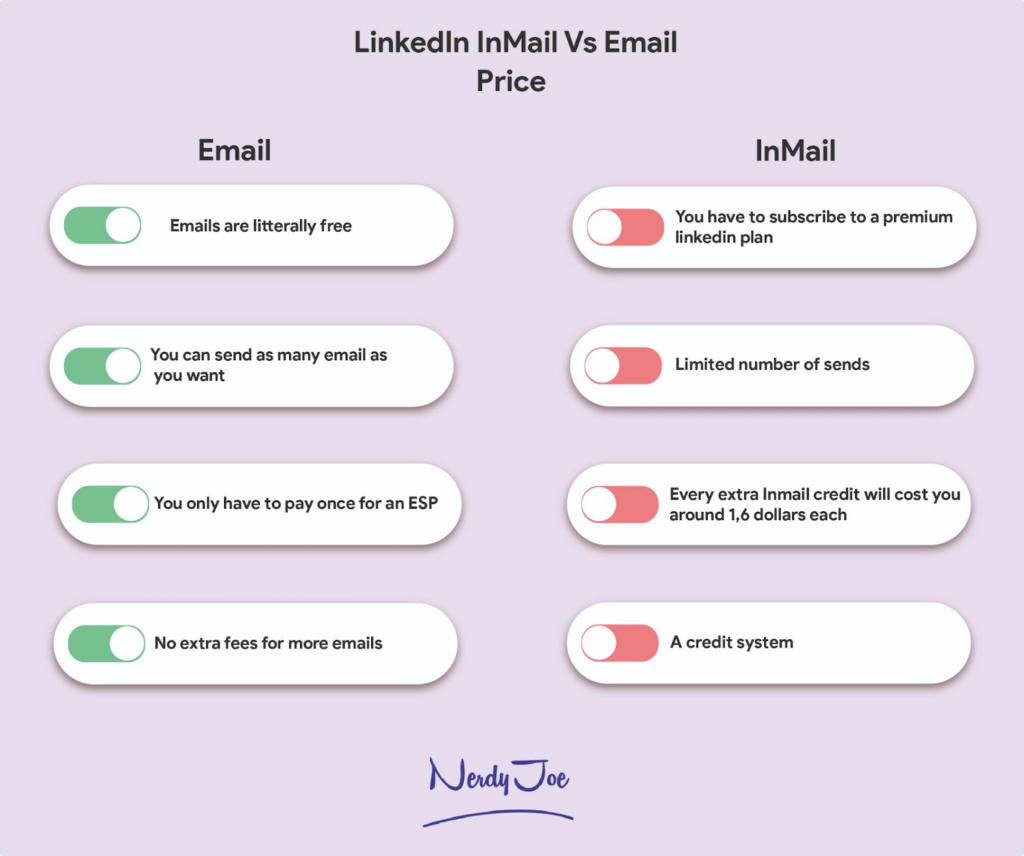
As precised earlier, the price is the first key differentiator between emails and LinkedIn InMails.
Emails are literally free; you can program and send as many emails as you need to close your prospects without paying an extra penny.
You will only have to subscribe to an email service provider tool like Hunter.io, MailChimp, Lemlist, etc., to help you create emails, reach prospects, and collect and make sense of campaign data.
On the contrary, InMail requires you to upgrade to a LinkedIn premium account or subscribe to a Sales Navigator plan. In other words, it costs extra, and only premium users can access the feature. Ideally, you will pay:
- $29.99 per month for the premium career which gives you only 5 InMail credits.
- $47.99 per month for the premium business, which gives you 15 credits.
- $79.99 per month for the Sales Navigator Core which gives you 50 credits.
- $125 per month for the Sales Navigator Advanced which gives you 50 credits.
If you have to bill monthly, the prices tick up.
Interestingly, LinkedIn offers a credit back for every response you get, positive or negative, within 90 days of the sending date.
You can contact the LinkedIn service team to purchase more credits for InMail messages if you need.
Be aware that an extra InMail credit will cost you around $1.6 each in the Sales Navigator Core — it all depends on the type of account you have.
LinkedIn also limits the number of monthly InMail credits you can combine, and it is 150 — you can’t get or send any extra within 30 days. Also, InMail message credits expire after 90 days.
With InMails, you are literally paying a dollar and a half for each message you send.
At the same time, you can send thousands of emails—with no connection request, without worrying about the price, sending limitations, or your account being banned or restricted.
LinkedIn message vs. Email: Follow-ups
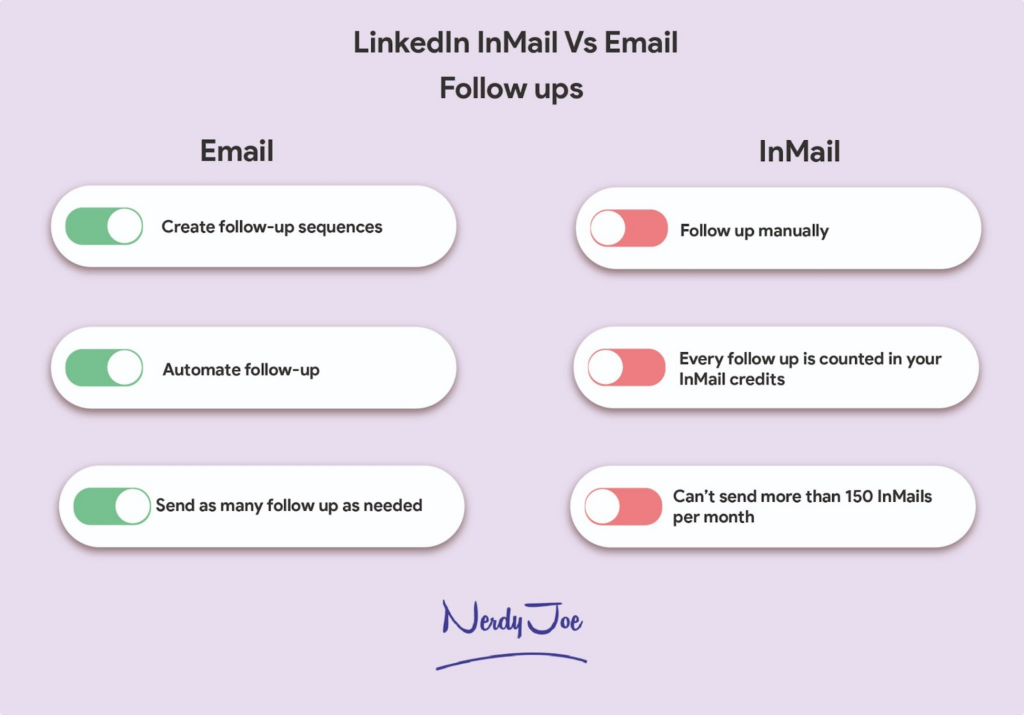
You can’t possibly reach out to your prospect with the product price and expect them to buy immediately.
You need to break the ice. Prove your worth. Provide value. Educate them on your offer or product. Create some product experience and more before you can get prospects to consider you.
Case in point, statistics show that 50% of all cold outreach sales or conversions occur after the 5th touch.
So, the question is: Can you follow up on your previous messages and build meaningful relationships?
The answer is yes for both channels.
You can send as many follow-up emails as you want, and a LinkedIn InMail message without a reply is counted toward your InMail credits and the 150 monthly quotas.
LinkedIn InMail vs Email: Automation
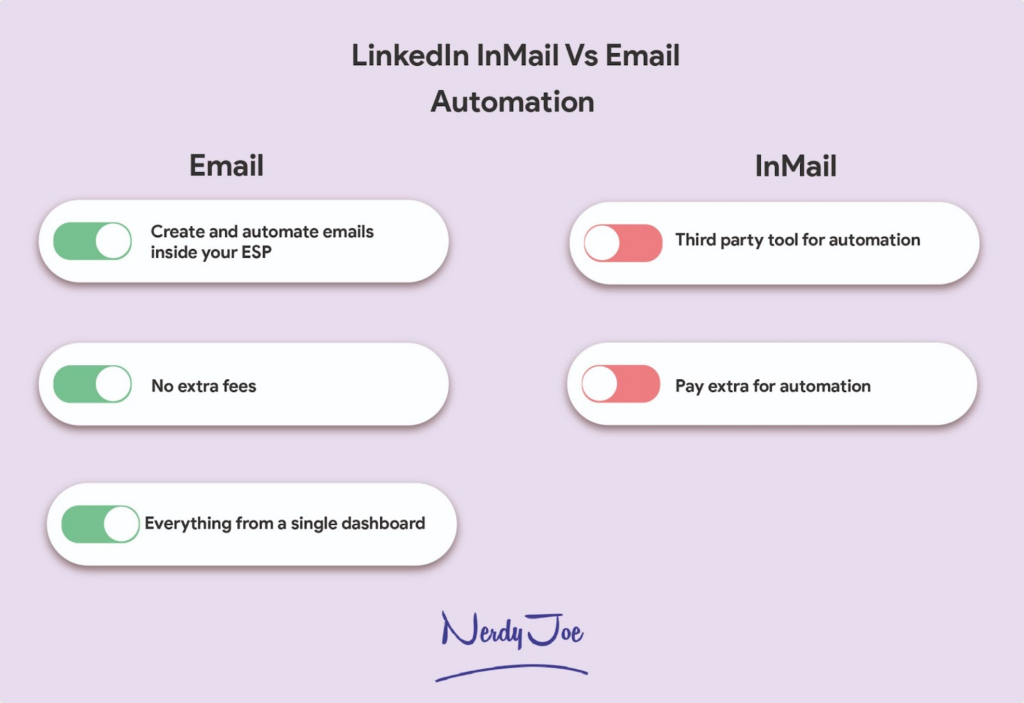
Both channels let you automate the sending of your messages and follow-ups. You can create and send multistage message sequences to your prospects.
You can also send automated trigger-based messages based on recipients’ actions.
But here is the difference, while most email service providers (ESPs) you use to send your emails offer this as a native function in the single plan you pay for, you’ll need to pay extra to integrate an InMail automation tool with your LinkedIn account.
LinkedIn InMail vs Email: Analytics
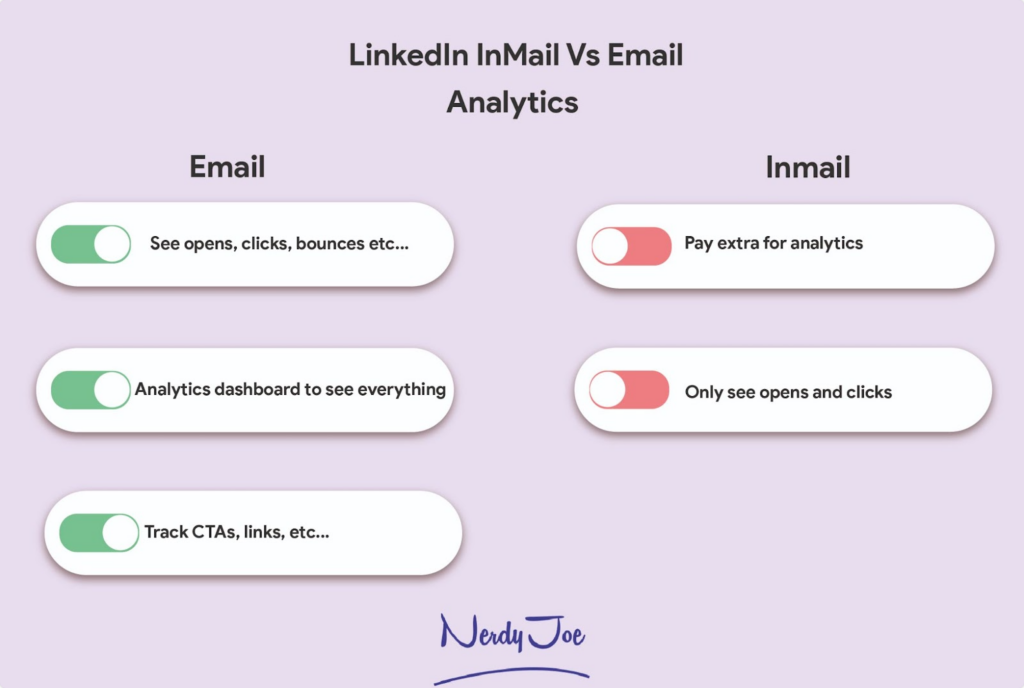
We cannot overstate the importance of analytics in marketing and especially cold outreach campaigns.
Analytics offer information you need to make sense of your outreach result and improve for the future. Luckily, both cold email and LinkedIn InMail provide you with outreach analytics.
All ESPs offer campaign analytics as a native feature. Users get reports regarding the number of opens, clicks, bounces, and all.
You can attach and track the attached documents. You can even expect specific reports pertaining to a specific email.
LinkedIn lets you see response and acceptance rates after you send InMails. You can also see how many messages have been declined or received no response.
But contrary to ESPs, LinkedIn does not provide analytics for free. You have to fork out extra dollars to get analytics for your campaigns.
LinkedIn InMail vs Email: Segmentation and Personalization
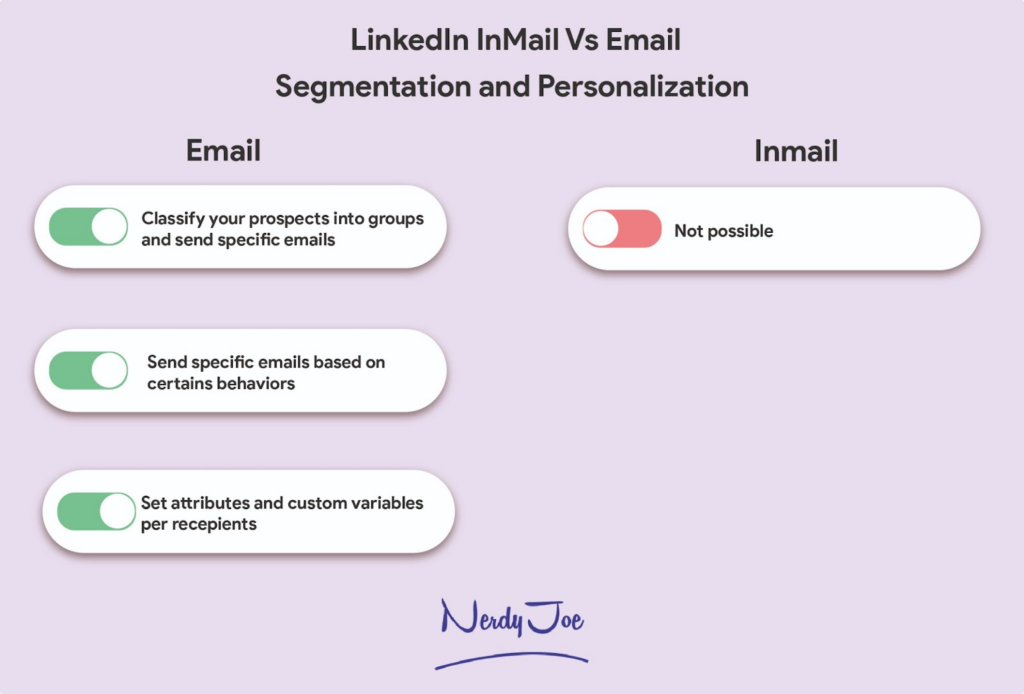
These two outreach practices constitute the first step to any successful cold outreach strategy, be it on LinkedIn or by email.
People are sick of generic, templatized message blasts. They want messages that indicate the sender knows them and understands their unique problems and needs.
That’s where segmentation and personalization come in—especially if you send bulk messages.
Chances are, you’ll have multiple ideal customer profiles (ICPs), and you cannot feed them all the same content.
You need to be able to classify your prospect into groups in your sending tool, and that’s the very reason you need segmentation and personalization features.
Here again, most ESPs you will use to send email campaigns allow for segmentation and personalization.
You can set your prospects into groups, create different funnels, and customize the message they receive.
Even better, you can automate the insertion of the recipients’ names, job titles, and other details you need to personalize and make the message specific to them. But none of it is possible with LinkedIn InMail messages.
LinkedIn InMail vs Email: User Engagement Rate
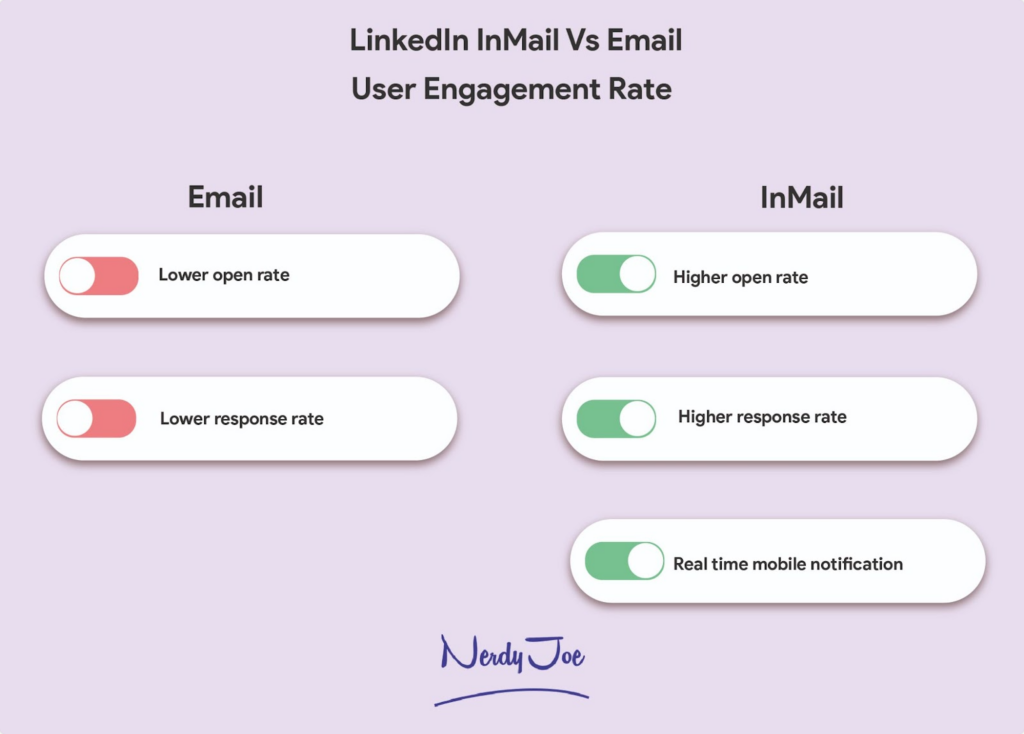
So, on which channel is your message the most likely to be read and replied to?
Here are what the figures say about this.
- The average open rate for LinkedIn InMail messages is about 57.5%
- The average email open rate is about 21.6%
- The average response rate for LinkedIn InMail is between 10-25%
- The average email response rate is anywhere between 1 to 10%.
Obviously, InMails have better engagement rates than email. This can be explained by the fact that InMails are more interactive, and recipients can easily check your LinkedIn account to see who you are.
Also, InMail lands in recipients’ inboxes as a personal message, and most people use LinkedIn on their mobile devices. On top of that, LinkedIn notifies them, which makes it easy to quickly pick up the phone and check out.
Keep in mind that these are industry-defined figures and are in no way indicative of the engagement rate you should expect.
You can always get a 100% response rate on your email or InMail, should you approach it the right way. Case in point, we had a 93% open rate in one of our cold outreach campaigns at Nerdy Joe.
LinkedIn InMail vs Email: Sending Time
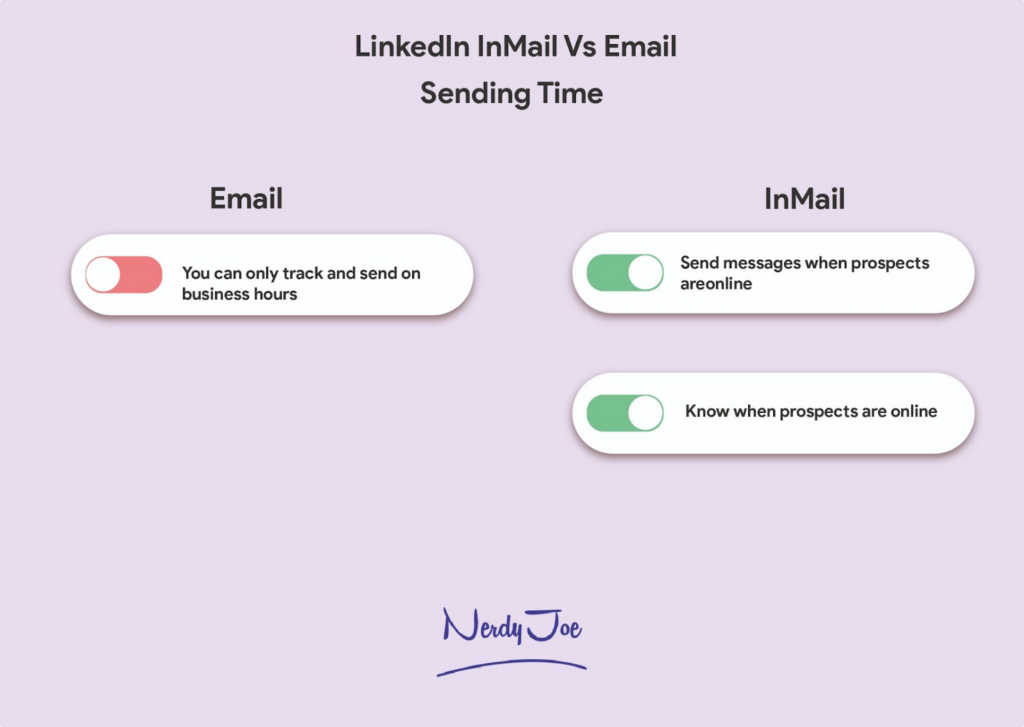
Sending your message at the best time can make the difference between a message that gets opened and one that gets ignored.
While a lot of marketers have theories about the best time and frequency to send emails, Linked InMail wins this battle.
The simple reason is that it is an engagement-driven platform, and LinkedIn’s active status feature lets you know who is online and who is not. It even lets you know the last time the user logged into their account.
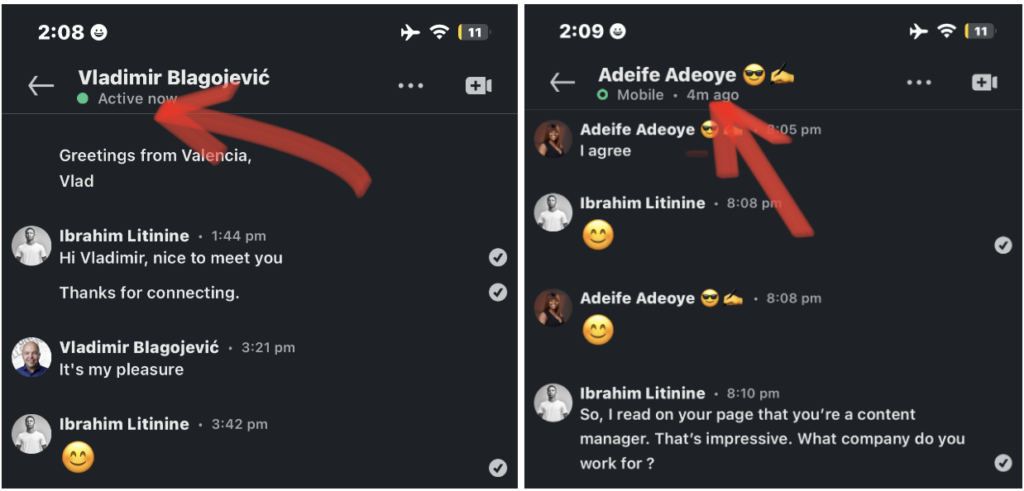
This makes it easy to send the message exactly when prospects are online, and it helps maximize engagement.
Read more: How to Create Cold Email Sequences That Generate Sales (Pus a Sequence Template)
Why LinkedIn InMail might be a better choice than email?
Here are a few instances where using LinkedIn InMails might be more beneficial than using emails.
You can’t find prospects’ email addresses
Let’s face it, even with the superpower of prospecting tools like Hunter.io, it’s sometimes hard or just impossible to find certain email addresses.
So, if you’re having a hard time finding your prospects’ email addresses, then sending them an InMail can be a nice alternative.
An even better alternative than sending the message to another person or sending it with a “redirect note” to info@domainname.com.
You are targeting a very short prospect list
If you are targeting a really short prospect list, ideally between 5 to 10 prospects, it can be a great idea to use LinkedIn InMails over emails.
This will save you time, and you can send the InMails one-on-one.
Also, since you will not need many ESP features, you can create a spreadsheet and manually enter your campaign metrics and analytics and treat them to your content. Understandably, it can take a lot of effort and be hard to scale.
You prefer a single platform for prospecting and outreach.
If you already own a LinkedIn account that you use for prospecting and want to do both prospecting and outreach on a single platform, then you can dig into LinkedIn InMails.
You want fast results
People check their social media notifications more than they check new emails. So if you can create highly personalized InMails, you can expect high opens and response rates in record time with LinkedIn InMails.
Especially since LinkedIn allows users to add inmail subject lines, you can get your prospects to open your messages really fast.
Prospects do not respond to cold emails.
If your cold emailing strategies are not cutting it, you can consider using InMails to reach out to your prospects.
Why sending a cold email is the best option over inmail?
Sending cold emails is a better option than sending LinkedIn InMails almost all the time. Here are the main reasons why:
You can send more emails than InMails
While InMails are limited by your monthly plan and have a 150 quota, you can’t exceed, ESPs lets you send as many emails as you need to close your prospects. Plus, technologies like Hunter.io and ZoomInfo makes it easy to find contact information.
You can access segmentation and personalization features
If you can’t segment your prospects’ list and add their personal details to the message, your outreach campaign is bound to flop.
You need to ensure each prospect feels the message they receive is specifically targeted to them.
With these features, ESPs allow you to separate your prospects into groups of people with common traits.
You’ll be able to add their personal info to the message to personalize it. You can add their names, unique icebreakers, personalized PS notes, and more.
Read more: How To Write A Follow-up Email After No Reply (+ 10 Templates)
You will not get restricted because of heavy activity
Using LinkedIn for both prospecting and outreach might not be a good idea because the platform has strict rules against unusual activities, especially if you have a new account.
For example, the platform controls the number of connection invites you send, monthly searches you perform, the number of profiles you visit, and of course, the number of messages.
If your activities appear to be unusual, you’ll see your account restricted.
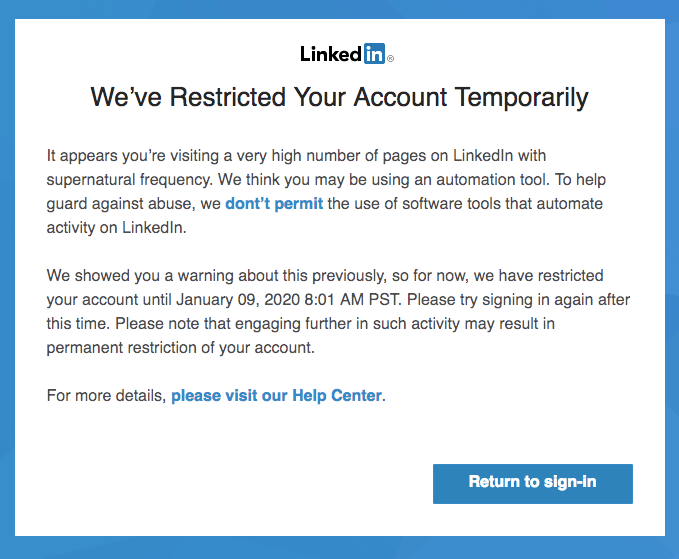
Meanwhile, you can search for as many email addresses as you need and send them emails; no ESP will ever restrict your account.
However, you need to ensure not to spam your recipients. If too many people send your emails to the spam folder, you will struggle with deliverability.
But as long as you send valuable and legitimate emails, you’re fine. No matter which platform you use, prospects will respond to you if you provide value and capture their attention.
Read more: 30+ Effective Sales Email Subject Lines To Get More Replies
You will have more data to chew on
One of the main reasons cold emailing is so darn effective is that you can use your previous campaign statistics to improve your next emails.
ESPs provide you with such email marketing metrics and KPIs as the open rate, click-through rate, reply rate, deliverability rate, and more.
At the same time, not only is it a paid feature with InMails, but you will not have as many campaign analytics. It only reports opens and responses.
But ESPs give you more analytics of your campaign. These can help you understand what’s not working in your messages and improve them.
For example, a low click-through rate indicates that your content may not be as valuable as you think. And so, you need to improve.
Read more: How To Write A Follow-up Email After No Reply (+ 10 Templates)
Prospects do not respond to your InMails
If someone does not respond on one platform, they might on another.
If your prospects are not responding to your messages on LinkedIn, check their LinkedIn profiles and search for their emails. Then email them. It is an even more professional way to approach them.
Read more: 450+ Spam Trigger Words to Avoid in Your Copy
Key takeaways
- Emails facilitate outreach with personalization and scalability features. You can send mass emails and reach out to as many targets as you want. You define the number of emails needed to complete your campaign, and you can segment your prospects and personalize your message. You can automate the sending process, the follow-ups, and more.
- LinkedIn InMails are ideal if you want to target a short list of high-profile targets in a short time period without too much hassle. You can find them on the platform and send them personalized InMails. Plus, InMails have better engagement results than emails, so you’ll have more chances to engage with busy people.
- Emails cost almost nothing compared to InMails. With InMails, you literally pay for each and every message you send—plus, you must keep an eye out for a monthly limit. With emails, you only need to pay for your ESP, and you’re good to go. You can send thousands of emails to thousands of prospects.
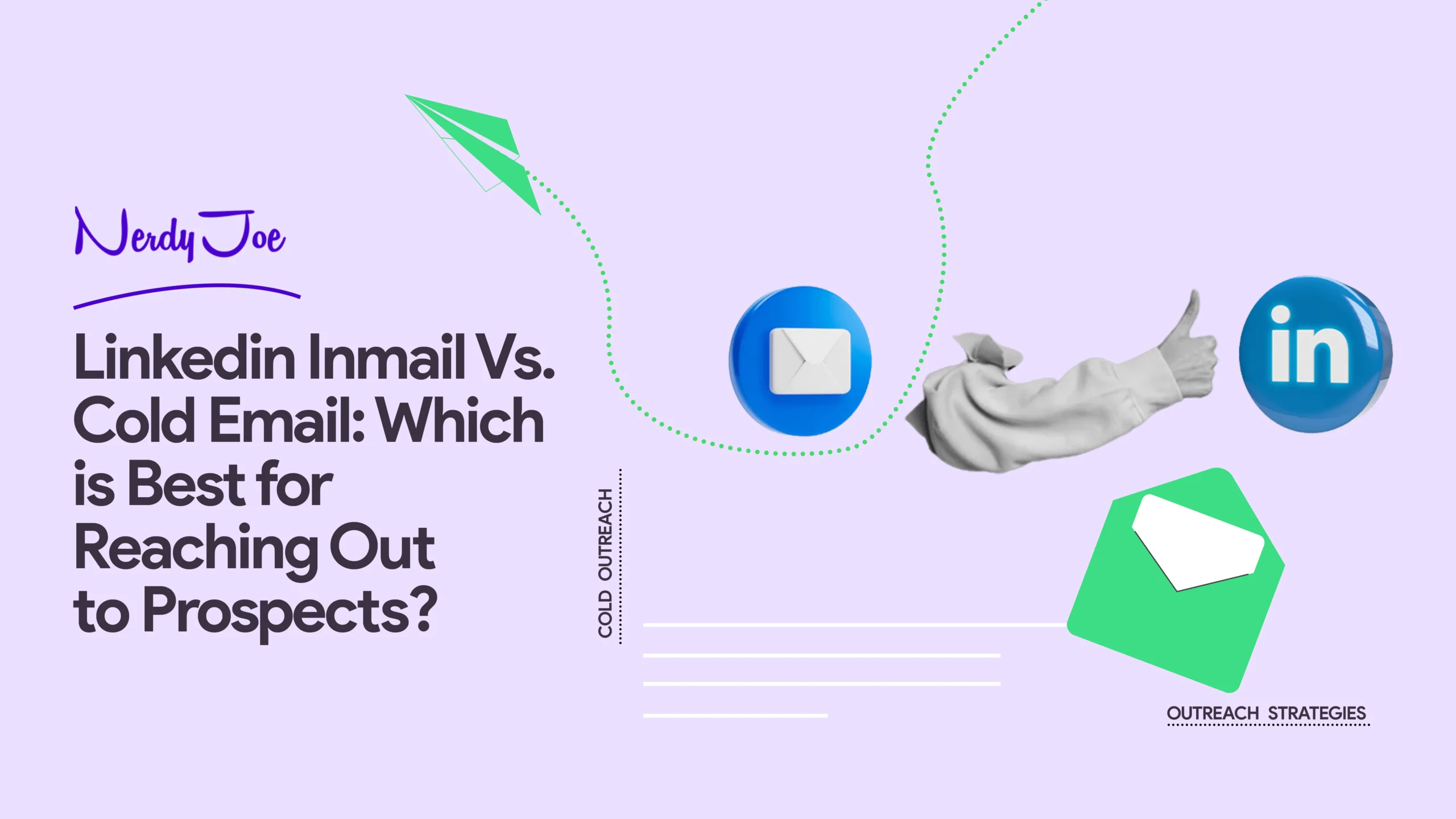
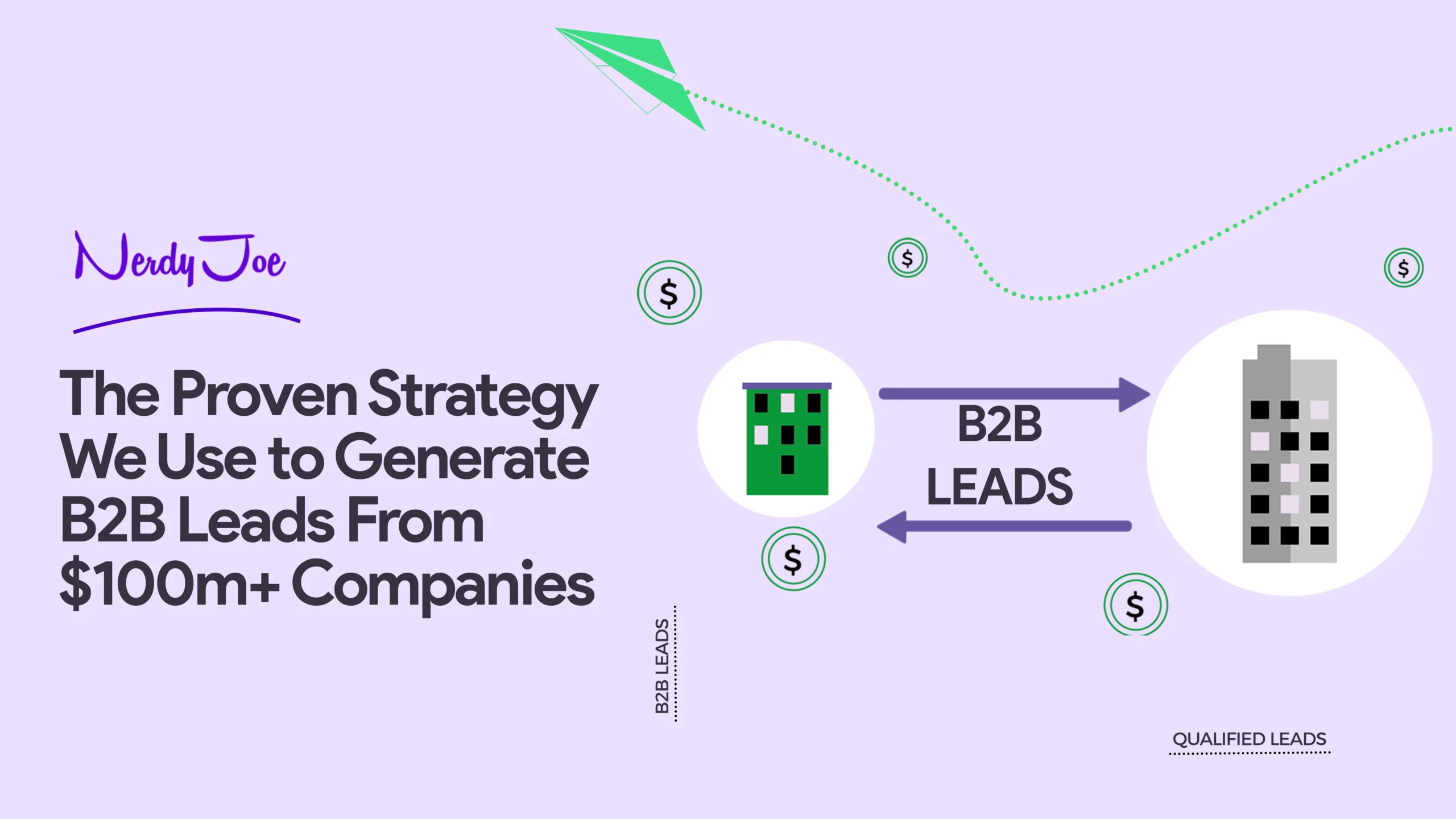
![How to Generate B2B Leads With Cold Outreach [Case Study]](https://nerdyjoe.com/wp-content/uploads/2024/06/1669218674-artboard-1-copie-4-3x-1-scaled.webp)
